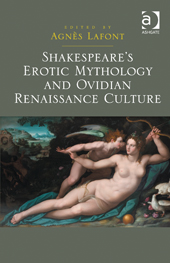
Shakespeare's erotic mythology and Ovidian Renaissance Culture
Sous la direction de Agnès Lafont
Londres : Ashgate, 2013.
EAN 9781409451310.
224 p.
Prix 99,95 USD
Présentation de l'éditeur :
Taking cross-disciplinary and comparative approaches to the volume’s subject, this exciting collection of essays offers a reassessment of Shakespeare’s erotic and Ovidian mythology within classical and continental aesthetic contexts. Through extensive examination of mythological visual and textual material, scholars explore the transmission and reinvention of Ovidian eroticism in Shakespeare’s plays to show how early modern artists and audiences collectively engaged in redefining ways of thinking pleasure.
Within the collection’s broad-ranging investigation of erotic mythology in Renaissance culture, each chapter analyses specific instances of textual and pictorial transmission, reception, and adaptation. Through various critical strategies, contributors trace Shakespeare’s use of erotic material to map out the politics and aesthetics of pleasure, unravelling the ways in which mythology informs artistic creation. Received acceptions of neo-platonic love and the Petrarchan tensions of unattainable love are revisited, with a focus on parodic and darker strains of erotic desire, such as Priapic and Dionysian energies, lustful fantasy and violent eros. The dynamics of interacting tales is explored through their structural ability to adapt to the stage. Myth in Renaissance culture ultimately emerges not merely as near-inexhaustible source material for the Elizabethan and Jacobean arts, but as a creative process in and of itself.
Contents: Introduction: interacting with Eros: Ovid and Shakespeare, Agnès Lafont; Part I Erotic Aesthetics and Printing Politics: Ovid’s ‘meta-metamorphosis’: book illustration and the circulation of erotic iconographical patterns, Ilaria Andreoli; Political uses of erotic power in an Elizabethan mythological programme: dangerous interactions with Diana in Hardwick Hall, Agnès Lafont. Part II Shakespeare’s Erotic Power of Imagination: Erotic fancy/fantasy in Venus and Adonis, A Midsummer Night’s Dream and Anthony and Cleopatra, François Laroque; Erotic perspectives: when Pyramus and Thisbe meet Hero and Leander in Romeo and Juliet, Janice Valls-Russell. Part III Shakespeare’s Erotic Power of Recreation (and Miscreation): Parodic Interactions with Darker Desires: Priapus in Shakespeare: luxuriant gardens and luxurious brothels, Frédéric Delord; Parody and the erotic beast: relocating Titania and Bottom, Stuart Sillars; Flirting with Erotic Taboos: Cupid, infantilism and maternal desire on the early modern stage, Jane Kingsley-Smith; Queering Pygmalion: Ovid, Euripides and The Winter’s Tale, Sarah Annes Brown; Deadly Rapture: The ‘new Gorgon’: Eros, terror. and violence in Macbeth, Marguerite Tassi. Part IV Coda: Femmina masculo e masculo femmina: Ovidian mythical structures, Leonardo da Vinci, Michelangelo and As You Like It, Yves Peyré; General bibliography; Index.
Agnès Lafont is Senior Lecturer in Early Modern Studies in the English Department at Université Paul Valery Montpellier III, France.
Vous pouvez lire l'Introduction de cet ouvrage.